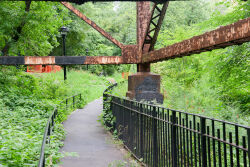West Farms Rapids
The Daily Plant : Monday, October 23, 2006
Pop Goes The Herring?
From August through September, Parks & Recreation’s Natural Resources Group (NRG) staff, Wildlife Conservation Society (WCS) personnel and volunteers from Lehman College, Rocking the Boat and the community have kept their eyes peeled for “popping” on the Bronx River. Popping refers to the feeding behavior of juvenile alewife, which involves a leap out of the water to capture insects as they emerge. The characteristic flash of silver and small splash differentiates popping by these fish from other disturbances on the river.
Alewife, a species of river herring, were reintroduced to the Bronx River, at the Bronx Zoo, on March 21, 2006 from a stream in Connecticut, through a combined effort from NRG, the Connecticut Department of Environmental Protection’s Inland Fisheries Division, Lehman College, the Bronx River Alliance, WCS, and other community partners. After being released into the Bronx River, the transplanted alewife laid low, in deep portions of the river, biding their time until the waters warmed and they could begin spawning. This spawning began in April 2006, resulting in the first generation of Bronx River born alewife since the first dam was built on the river, more than 350 years ago. The adult fish then abandoned their thousands of fertilized eggs and migrated back to the Atlantic Ocean. The embryos eventually hatched into larvae and the larvae grew to become juveniles. At approximately 2” in length, the juveniles begin “popping” during feeding. The juvenile alewife use a variety of cues, including water temperature and day length, to recognize when they ought to follow in their parents’ fin-steps and return to the sea.
To determine whether the spawning was successful, and the juvenile alewives survived, popping surveys were conducted. Employees from NRG, WCS and volunteers counted the number of pops they observed at two locations in the Bronx River during one hour before dusk, three evenings a week from July 18 through the end of September. The evening of August 15 marked the first observed popping on the Bronx River. Observers measured the most activity on August 17, September 7 and September 20, and continued to witness popping until the conclusion of the survey on September 28. These observations confirmed the initial success of the alewife reintroduction project. If all goes as planned the young fish seen this year will return by 2011 as adults to spawn and continue the cycle.
Popping surveys have the advantage of not requiring physical contact that can stress and harm young fish - an obvious advantage over other monitoring techniques. In order to compare alewife activity over multiple seasons, popping surveys will continue for at least the duration of the reintroduction project. Reintroduction efforts will continue for at least the next four years, perhaps longer depending on its success and funding. The goal of the project is to produce a sustainable alewife population in the Bronx River.
If you are interesting in volunteering your time for next year’s popping season please contact Jesse Moore at (212) 360-1466 or Marit Larson at (212) 360-1415.
Written by Jesse Moore
FOREST PARK COMMUNITY DAY DRAWS NEW VISITORS
On September 30, Forest Park held its first Community Day at Jackson Pond, an area of Forest Park bordering Richmond Hill, Queens. This first-time event was part of the J.M. Kaplan Immigrant Outreach project and aimed to engage the Indo-Caribbean community in Richmond Hill.
Forest Park partnered with the Rajkumari Cultural Center, a fixture of Richmond Hill, to put on Community Day. The Rajkumari Cultural Center used this opportunity to perform its 9th annual Kitcherie event, a pageant of a traditional East Indian village weddings with time-honored styles of drumming, singing, dancing, costumes, and decoration. These traditions are still practiced by Indo-Caribbean people of Trinidad, Guyana, Suriname, and Jamaica living in New York neighborhoods. In real life, bamboo weddings are five days long but park visitors had a chance to share the excitement at Forest Park Community Day.
In years past, Kitcherie has been held indoors with an admission fee. Collaborating with Forest Park allowed Rajkumari to hold their event outside and free to the public. Approximately 500 people attended Community Day not only to enjoy this performance of Kitcherie, but also to get to know Forest Park by playing games provided by Recreation and making fall crafts. Additionally, the New York Immigration Coalition offered multi-lingual voter registration, South Asian Youth in Action! offered youth development programs, and SAMAR conducted a bone marrow drive. Jamaica Hospital provided free health screenings and the Natural History Mobile Museum presented families with a fun and informative space to enjoy. Kaichore, a popular restaurant in Richmond Hill sold great Indo-Caribbean food. Another highlight was the three talented Tassa, or Trinidadian, drummers who wandered through the park to drum up excitement and draw visitors to the performance area. Two of the most popular areas of Community Day were the sari-tying and henna painting areas, where people lined up to learn to tie a sari and have intricate decorations applied to their hands.
This first-time collaborative event is a part of the J.M. Kaplan Immigrant Outreach Initiative at Forest and Highland Parks, which will continue there until next summer. For more information about the project or about Community Day, please call Neerja Vasishta, Immigrant Outreach Coordinator, at (718) 235-4462; e-mail her at neerja.vasishta@parks.nyc.gov, or visit her at Oak Ridge in Forest Park, Queens.
Written by Neerja K. Vasishta
QUOTATION FOR THE DAY
“Oh, somewhere in this favored land the sun is shining bright;
The band is playing somewhere, and somewhere hearts are light,
And somewhere men are laughing, and somewhere children shout;
But there is no joy in Mudville - mighty Casey has struck out.”
Ernest L. Thayer
(1863-1940)
Check out your park's Vital Signs
Clean & Safe
Green & Resilient
Empowered & Engaged Users
Share your feedback or learn more about how this park is part of a
Vital Park System










